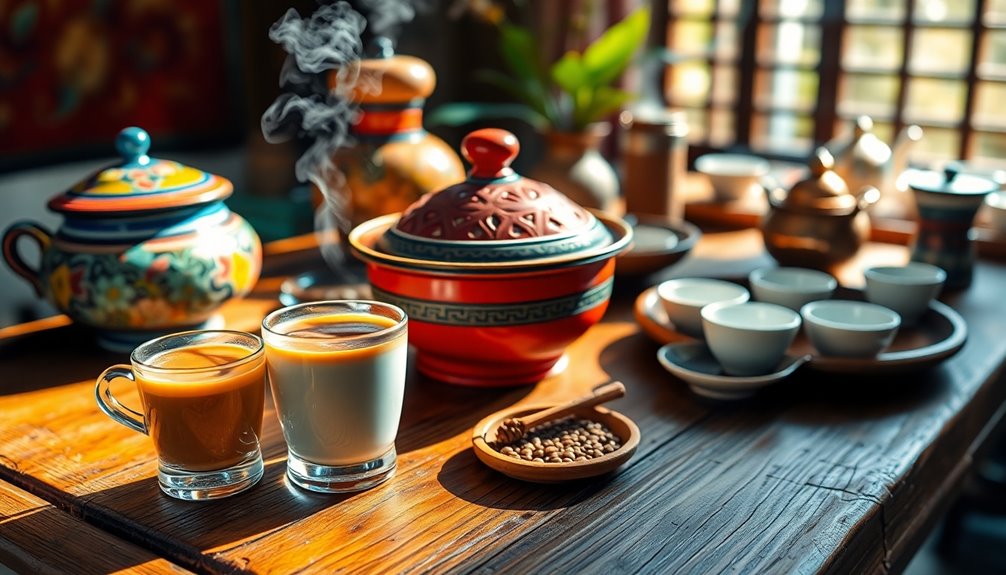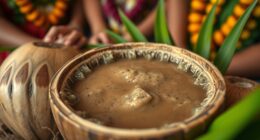You can easily make kombucha without tea by using sweet liquids like fruit juice or herbal infusions. Start by boiling water and dissolving sugar in it for a base. Then, add ingredients like blue pea flowers for flavor and color. Allow the mixture to cool, strain it into a glass jar, and add a healthy SCOBY. Ferment this concoction in a cool, dark place for 3 to 5 days, tasting regularly to find your desired sweetness. With some creativity and the right techniques, you'll create a rejuvenating drink. Explore further to discover even more tips and tricks!
Key Takeaways
- Use 1 liter of water, 120g of sugar, and 25-30 blue pea flowers for a flavorful base without tea.
- Boil water, dissolve sugar, and steep blue pea flowers for at least 30 minutes to infuse flavor.
- Cool the mixture below 40°C, strain it into a glass jar, and add a healthy SCOBY for fermentation.
- Ferment in a cool, dark place for 3 to 5 days, tasting periodically to monitor sweetness and tanginess.
- Experiment with flavoring techniques like adding fresh fruits or herbs during secondary fermentation for unique taste profiles.
About Kombucha

Kombucha, a fizzy and tangy drink, is gaining popularity for its unique flavor and health benefits. Typically brewed from sweetened tea, this fermented beverage can also be made with various non-tea liquids, allowing for creativity in your brew.
The magic happens during fermentation, where a SCOBY (Symbiotic Culture of Bacteria and Yeast) transforms sugary liquids into a deliciously tart drink rich in probiotics. While traditional kombucha uses black or green tea, experimenting with ingredients like gula melaka and blue pea flowers can elevate your flavor profile.
To guarantee success, maintain a healthy SCOBY and remember that ideal fermentation time ranges from 3 to 5 days, depending on your preference for sweetness and tanginess.
Benefits of Non-Tea Kombucha

Non-tea kombucha opens up a world of unique flavor profiles, giving you the freedom to experiment with various sweet liquids and ingredients.
You can enjoy this invigorating drink without worrying about caffeine, making it perfect for any dietary preference.
Plus, it still offers the health benefits you'd expect from traditional kombucha, supporting your gut health and overall wellness.
Unique Flavor Profiles
Have you ever considered how diverse your kombucha options can be without using tea? Non-tea kombucha opens up a world of unique flavor profiles by using sweet liquids like fruit juices or herbal infusions. Ingredients such as gula melaka and blue pea flowers not only add flavor but also enhance the visual appeal of your brews.
| Flavor Base | Flavor Profile |
|---|---|
| Fruit Juice | Sweet and Fruity |
| Herbal Infusion | Earthy and Aromatic |
| Gula Melaka | Caramel and Nutty |
| Blue Pea Flowers | Floral and Vibrant |
The fermentation process still relies on a strong SCOBY, transforming these sugary liquids into tangy, probiotic-rich drinks in just 3 to 5 days.
Dietary Flexibility
Many people find that non-tea kombucha offers exciting dietary flexibility, allowing you to explore a range of flavors that cater to your preferences.
By experimenting with sweet non-tea liquids like fruit juices and herbal tea infusions, you can create delicious drinks without the caffeine found in traditional teas. The fermentation process still uses a healthy SCOBY and sugar, ensuring you enjoy the probiotic benefits. Herbal teas, which are known for their health benefits, can enhance the nutrition and flavor of your kombucha. Additionally, some herbal teas may have anti-inflammatory properties, adding even more health benefits to your beverage. Juices like beet juice can also be incorporated for their improved blood flow benefits, enriching your kombucha with extra nutrition. Maintaining a balanced diet is essential for overall health and can complement your non-tea kombucha choices.
Unique ingredients like blue pea flowers or gula melaka add vibrant colors and tastes, making each batch a new adventure. Additionally, using herbal teas as a base can alter the fermentation process and flavor profile, providing even more variety in your kombucha creations.
Whether you're following a caffeine-free lifestyle or specific diet, non-tea kombucha lets you tailor your beverages to meet your nutritional goals while savoring the tangy profile you love.
Health Benefits
While you might think of kombucha as strictly a tea-based beverage, non-tea versions offer a wealth of health benefits that are hard to ignore.
Non-tea kombucha, made from sweet non-tea liquids, still provides probiotics that support gut health and aid digestion due to the fermentation process. This fermentation creates beneficial acids that can help regulate blood sugar levels and improve metabolic health. Additionally, the high fiber content in ingredients like chia seeds can further enhance digestive health. Consuming foods rich in antioxidants can also support overall wellness by combating oxidative stress. Organic juices can also be incorporated into non-tea kombucha for added flavor and nutrients.
Plus, non-tea kombucha hydrates you with flavors from ingredients like blue pea flowers, which are rich in antioxidants that can enhance skin health and contribute to anti-aging effects. Additionally, incorporating ingredients like flower teas can further boost the nutritional profile and flavor of your kombucha.
If you're sensitive to caffeine, non-tea kombucha lets you enjoy the probiotic benefits without the jitters, all while offering a diverse range of nutrients beyond traditional options. This makes it an excellent alternative for those looking to incorporate nutrient-dense options in their diets.
Essential Ingredients

To create a delicious kombucha without tea, you'll need to gather a few essential ingredients that form the foundation of your brew.
Start with 1 liter (4 cups) of water and add 120g (1/2 cup + 1 tablespoon) of caster or granulated sugar to create a sweet base for fermentation.
Next, incorporate 25-30 blue pea flowers, either fresh or dried, to infuse your kombucha with unique flavor.
A healthy kombucha SCOBY is vital, as it contains the necessary bacteria and yeast for fermentation.
Optionally, you can add 120ml (1/2 cup) of store-bought kombucha to introduce live cultures and boost acidity, helping to prevent mold.
Brewing Process

The brewing process for kombucha without tea is straightforward and rewarding. Start by boiling 1 liter (4 cups) of water and dissolving 120g (1/2 cup + 1 tablespoon) of sugar. Then, add 25-30 blue pea flowers and simmer briefly.
Follow these key steps:
- Steep the flowers in the sugar water for at least 30 minutes.
- Cool the mixture to below 40°C and strain it into a glass jar.
- Optionally, add 120ml (1/2 cup) of kombucha as a starter culture and introduce a healthy SCOBY for fermentation.
- Ferment in a cool, dark place for 3 to 5 days, tasting periodically.
Once you reach your desired flavor, bottle it and refrigerate to stop fermentation. Enjoy your homemade brew!
Tips for Successful Fermentation

To achieve successful fermentation, start with a strong and healthy SCOBY; it's essential for non-tea liquids.
Keep an eye on the fermentation time, ideally between 3 to 5 days, to prevent spoilage.
Finally, remember to return your SCOBY to sweet tea afterward to keep it thriving for your next batch.
Healthy SCOBY Importance
While experimenting with non-tea liquids for your kombucha, maintaining a strong and healthy SCOBY is essential for successful fermentation. A robust SCOBY guarantees the right balance of bacteria and yeast to convert sugars into a tangy beverage.
Here are some tips to keep your SCOBY thriving:
- Return it to sweet tea after fermenting non-tea liquids to maintain its health.
- Use 120ml (1/2 cup) of kombucha as a starter culture for new non-tea recipes.
- Regularly taste your brew to gauge sweetness and tanginess, indicating SCOBY effectiveness.
- Aim for an ideal fermentation time of 3 to 5 days to avoid spoilage.
Fermentation Time Guidelines
Fermentation time plays an essential role in crafting your non-tea kombucha, as it directly impacts the flavor and overall quality of your brew.
The ideal fermentation time for non-tea kombucha is between 3 to 5 days. During this period, regularly taste your kombucha to monitor its sweetness and tanginess, adjusting to your personal preference.
Keep in mind that environmental factors like temperature and humidity can influence how quickly your kombucha ferments; warmer conditions usually speed up the process.
If you want carbonation, consider a secondary fermentation, although it's not necessary for achieving that initial tangy flavor.
After fermentation, remember to return your SCOBY to a sweet tea base to maintain its health for future batches.
Maintain SCOBY Health
Maintaining the health of your SCOBY is essential for successful fermentation, especially when using non-tea liquids. Here are some tips to keep your SCOBY thriving:
- Always return the SCOBY to a sweet tea base after fermentation for necessary nutrients.
- Confirm your SCOBY is strong and healthy before starting fermentation in non-tea liquids.
- Monitor fermentation time closely, aiming for 3 to 5 days to prevent spoilage.
- Gradually experiment with flavors and sweeteners, as the SCOBY may adapt slowly.
- Incorporate probiotics that may aid digestion from traditional kombucha to enhance the health benefits of your non-tea brews.
Using Alternative Sweeteners

Have you ever wondered how to sweeten your kombucha without traditional tea? Using alternative sweeteners can be a great way to experiment, but you need to choose wisely.
Avoid low-calorie sweeteners, as the SCOBY can't consume them, making fermentation ineffective. Sucrose sources like white or brown sugar work well, while high fructose options like agave should be skipped for the initial brew.
If you're looking for lower sugar options, try using half the usual amount, but guarantee there's enough sweetness for the SCOBY. Raw honey is another option, just remember not to boil it; this preserves its beneficial yeast and bacteria.
Refresh your SCOBY every other batch with sugar and black tea to keep it healthy during your kombucha brew adventures.
Flavoring Your Kombucha

Once you've figured out the sweetening process for your kombucha, it's time to explore how to flavor it creatively.
Flavoring your kombucha can elevate its taste and complexity. During the secondary fermentation, you can add a variety of ingredients to craft unique flavor profiles. Here are some ideas to get you started:
- Fresh fruit like berries or citrus
- Dried herbs such as mint or basil
- Exotic spices like ginger or cinnamon
- Specialty ingredients like gula melaka or blue pea flower
Make sure to taste your kombucha periodically during fermentation, typically around 3-5 days, to find your perfect flavor balance.
Remember, avoid using flavored store-bought kombucha as a starter to keep your creations uncontaminated.
Happy brewing!
Maintaining SCOBY Health

To keep your SCOBY thriving, you need to create the right environment for it, especially after fermenting in non-tea liquids. Regularly return your SCOBY to a sweet tea environment to guarantee it gets the necessary nutrients for peak growth. Monitor fermentation times closely; non-tea liquids shouldn't ferment longer than 3 to 5 days to maintain SCOBY integrity. Keep it in a cool, dark place to reduce light exposure and temperature fluctuations. Regularly inspect your SCOBY for signs of health, such as a firm texture and absence of mold.
| Aspect | Ideal Condition | Health Indicator |
|---|---|---|
| Environment | Cool, dark place | Firm, gelatinous texture |
| Fermentation Time | 3-5 days | No signs of mold |
| Nutrients | Sweet tea return | Active bubbles |
| SCOBY Condition | Strong and healthy | Vibrant and thick |
Community and Resources

Keeping your SCOBY healthy is important, but connecting with others who share your passion for kombucha can enhance your brewing experience.
Engaging with a vibrant community allows you to learn, share, and grow as a brewer. Here are some valuable resources to explore:
- Join online forums and communities dedicated to non-tea kombucha brewing.
- Follow social media accounts and hashtags for inspiration and updates.
- Participate in local workshops to learn from experienced brewers.
- Access blogs and YouTube channels that focus on innovative kombucha techniques.
Frequently Asked Questions
Is It Possible to Make Kombucha Without Tea?
Yes, you can definitely make kombucha without tea! Instead, you can use sweet non-tea liquids like fruit juices or herbal infusions.
Just make certain your SCOBY is strong and healthy to guarantee proper fermentation. Typically, the fermentation process takes around 3 to 5 days, but be cautious—too long can lead to spoilage.
Trying options like blue pea flowers can give your kombucha a unique flavor and vibrant color. Enjoy experimenting!
Do You Need to Use Tea for Kombucha?
Imagine making a smoothie without fruit—sounds odd, right?
Similarly, while you don't have to use traditional tea for kombucha, it's the sweet base that matters. You can ferment other sugary liquids, but a robust SCOBY is essential.
Just like a chef adapting a recipe, it may take some trial and error. Remember, after experimenting with non-tea options, always return your SCOBY to sweet tea to keep it healthy for future batches.
Can You Make Kombucha With Juice Instead of Tea?
Yes, you can definitely make kombucha with juice instead of tea!
Just use a strong SCOBY and sweetened juice as your base.
Don't forget to add about 120g of sugar, since the SCOBY needs it to ferment.
Monitor the fermentation closely for 3 to 5 days to prevent spoilage.
You can also add a bit of previously brewed kombucha to kickstart the process and experiment with different juice flavors for a unique taste!
How Do You Drink Kombucha for Beginners?
When you start drinking kombucha, stick to small servings of about 4 to 8 ounces to see how your body reacts. If you experience any discomfort or digestive issues, consider reducing your intake or consulting a healthcare professional. Additionally, understanding how to measure tea for kombucha properly will ensure that you maintain a balanced brew that suits your taste. As you become accustomed to kombucha, you can gradually increase your servings, paying attention to how your body responds.
Begin with unflavored options, avoiding added sugars that can upset your stomach. Always check the expiration date to verify it's fresh.
As you get used to it, aim for 1 to 2 cups daily. Pair it with meals to aid digestion and enjoy the tangy flavor alongside your food.
Conclusion
In summary, making kombucha without tea opens a world of possibilities for your brewing adventures. You'll discover that the flavors you can create are nothing short of magical, transforming simple ingredients into a fizzy elixir that dances on your palate. By nurturing your SCOBY and experimenting with unique recipes, you're not just brewing a drink—you're crafting a vibrant lifestyle. So plunge into, embrace your creativity, and let your kombucha journey bubble over with excitement!










